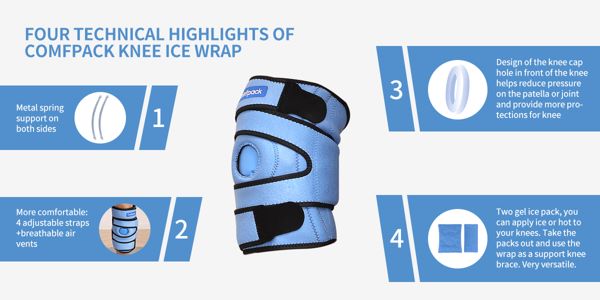By By Comfpack | 23 February 2022 | 0 Comments
Treatments for Knee Sprains
A knee sprain is a sudden overstretching of one of the ligaments of the knee, leading to a tear, inflammation, and pain. Knee sprains often affect the ACL or the PCL—the two ligaments that guide the front/back movement of the lower leg. Less often, knee sprains affect the MCL or LCL, which are the ligaments that run along the inner and outer sides of the knee.
Before a knee sprain can be fully treated, a medical evaluation will be necessary to determine the severity (grade) of the injury. This page describes the recommended treatments for knee sprains, as well as the steps patients can take to relieve pain and swelling during the days or hours before they see a doctor.
The R.I.C.E. method can help to stabilize the leg and decrease pain both before and after medical evaluation. This includes:
If you see an orthopedic physician promptly and treat the ligament injury properly, completing all prescribed physical therapy and rehab, the prognosis is excellent. You should be able to get back to playing sports within a few months.
Read more: 7 Things You Need to Do After Knee Replacement Surgery
Before a knee sprain can be fully treated, a medical evaluation will be necessary to determine the severity (grade) of the injury. This page describes the recommended treatments for knee sprains, as well as the steps patients can take to relieve pain and swelling during the days or hours before they see a doctor.
Immediate Treatment for a Suspected Knee Sprain
A knee injury can cause significant pain and swelling within seconds. The RICE method and anti-inflammatory medications can help reduce these symptoms while waiting for medical attention:The R.I.C.E. method can help to stabilize the leg and decrease pain both before and after medical evaluation. This includes:
-
- Rest: Resting the affected knee minimizes the risk of further injury or damage to the joint.
- Ice: An ice pack wrapped in a towel or a cool compress can be applied to the affected knee in fifteen minute intervals, pausing between each session to avoid damaging the skin. Icing the joint helps to reduce any swelling that is present.
- Compression: Wrapping an elasticized bandage around the knee can provide mild compression of the joint and help reduce localized inflammation. Patients are advised not to wrap the bandage so tight it is painful or cuts off circulation.
- Elevate. The injured knee should be elevated with a pillow or other soft object. This will prevent blood from pooling in the injured area and contributing to the swelling.
- Non-steroidal anti-inflammatories, such as ibuprofen, may be given to the athlete in order to reduce swelling in the affected knee.

Non-Surgical Treatments for Knee Sprains
The vast majority of knee sprains may be treated with non-surgical procedures that center on bringing the knee back to full strength.1. Physical therapy. Following an initial course of treatment for pain relief, it is typical for a knee sprain to be treated with physical therapy. Physical therapy will involve a mixture of exercises aimed at strengthening the knee and activities that increase and restore knee flexibility. Two primary components of physical therapy are:
2. Weight training: A physical therapist will have the patient lift small amounts of weight with in repetitive sets. This exercise may involve resistance bands, weighted braces or exercise equipment that involves the knee joint. Over time and in a controlled, progressive manner, the amount of repetitions and the weight being lifted will increase.
3. Stretching for flexibility. A therapist may also want to regularly measure the range of motion of a given athlete periodically and offer stretching exercises that may increase it. Typically, a return to a fully normal range of motion and flexibility is a sign that an athlete is nearly ready to return to athletic training.
The length and intensity of a physical therapy program will depend upon several factors, such as age, medical history, level of athletic competition and the severity of the knee sprain.
Surgery for Knee Sprains
In the event that the knee sprain is severe, surgery may be necessary to repair the damaged ligament(s). Surgery is typically only recommended if the knee sprain is a Grade III (full ligament tear).If you see an orthopedic physician promptly and treat the ligament injury properly, completing all prescribed physical therapy and rehab, the prognosis is excellent. You should be able to get back to playing sports within a few months.
Read more: 7 Things You Need to Do After Knee Replacement Surgery
Leave a Reply
Your email address will not be published.Required fields are marked. *
POPULAR BLOG
CATEGORIES
